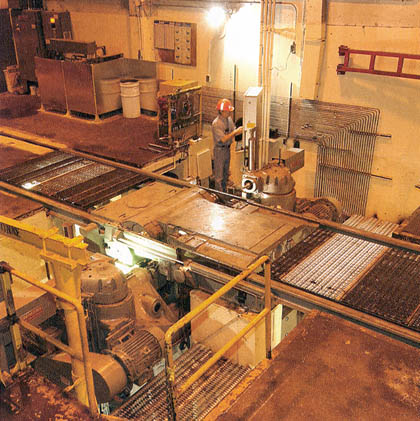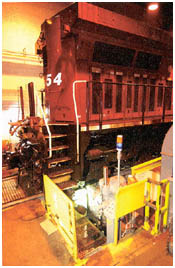 |
 |
|
|
|
|
|
Summer
2004

Canadian Pacific Railway Employee
Communications
Room 500 401-9th Ave S.W. Calgary AB T2P
4Z4
New Machine at St. Luc
Diesel Shop Helps Keep Wheels True

The wheel truing machine at St.
Luc Diesel Shop, along with six others across the system, turn more than
9,000 wheels annually.
Steel wheels on steel rail: if both maintain
their shape, there's little friction to impede the smooth and efficient
flow of heavy freight across the continent.
Railway locomotives and cars don't get blowouts. They do get flats, though,
and the uneven wear and the resulting bang-bang-bang action
can do serious damage to our track as they roll along. If the flat is
severe enough, it's off to the recycling bin for the errant wheel, but if
it's a minor defect then a trip to the "wheel truer" is in order.
 A wheel truer, or truing
machine, is, in effect, a metal lathe. CPR has seven of these useful
machines, located at Coquitlam, Calgary, Moose Jaw, Winnipeg, Toronto, St.
Paul, and Montreal to handle the more than 9,000 wheels CPR turns annually. A wheel truer, or truing
machine, is, in effect, a metal lathe. CPR has seven of these useful
machines, located at Coquitlam, Calgary, Moose Jaw, Winnipeg, Toronto, St.
Paul, and Montreal to handle the more than 9,000 wheels CPR turns annually.
The newest of these is at Montreal's St. Luc yard, where it was recently
installed by mechanical and engineering. "The first wheel ever turned
here was on 6 Oct 1955 by Pat Michaud", said Giulio
Capuano, Quebec production manager for mechanical services. "After
decades of useful service, the original machine had to be replaced".
On-site project manager Robert Lepine informed the NMC that
the wheel truing machine would be out of service from
8 Mar 2004 to 27 Apr 2004. Diesel shop process
manager Yvon Chalifour coordinated the staff required to complete the job.
And structures supervisor Christian St. Pierre oversaw protection of the
site for work on the electrical systems and the pit where the truing
machine is sunk in the shop floor.
Libero Plenzik, project manager with CPR's facilities management in Calgary,
reviewed the scope of the work and explained the procedures for receiving,
handling, and disposing of machine components.
The work was carried on each day from 8 a.m. to 4 p.m., under the guidance
of technicians from Simmons, manufacturers of the wheel truing machine.
Machinists Robert Dalpe, Richard Boujould, and Marcel Jacques, now retired,
were intimately involved with its installation.
"I'm proud of the whole team that worked on this project", Giulio
said. "And I'm thankful to our other diesel shops - Toronto, Alyth,
and St. Paul - for helping us get the spare parts that kept the old wheel
truing machine alive until this brand new state-of-the-art
machine could be acquired".
In about four weeks time, several days ahead of schedule, the truer was
ready for action. Since then, machinists Andre Gauthier, Florent Dufour,
and Claude Therrien - all fully certified by Simmons to man the control
console - have been back on the job, making sure that where steel wheel
meets steel rail, the business keeps rolling.
This Momentum
article is copyright 2004 by Canadian Pacific Railway and is reprinted
here with their permission. All photographs, logos, and trademarks are
the property of the Canadian Pacific Railway Company.
|
|
|
|